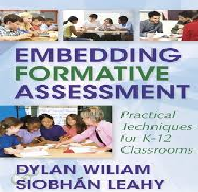Quick Formative and Embedded Formative Assessment Order Instructions: Create two formative assessment activities that could be used to gather specific information about student learning and performance.

Use the following criteria in developing your formative assessments:
Quick: The assessment activity should take no longer than 10 minutes.
Embedded: The assessment activity should be embedded into instruction.
Non-graded: The assessment results should be used to inform instruction but will not affect student grades.
Write a thorough description of each activity, including student directions, and reflect on how data from the assessment will be used to inform instruction.
Quick Formative and Embedded Formative Assessment Sample Answer
Embedded Formative Assessment
Embedded formative assessment is important in enhancing educator quality as well as learners skills when seen a procedure and not a tool. It involves the use of questioning, learning objectives feedback, teamwork, individual regulate learning and success criteria with the aim of engineering effective learning settings (Fisher & Frey, 2007). In addition, embedded formative assessment is the learning process that involves professional growth that provides the required content to help tackle the aspect of the complexity of changing educators’ practice. The objective is essentially to share teaching expertise and why reviewing practices is extremely complex. This is the reason, as to why it is important to ensure a supportive setting for educators to grow professionally together.
Quick Formative Assessment
With a quick formative assessment, an educator can be able to evaluate how best the student has grasped what was taught in class in their learning process.
- Outcome Sentences: This approach can be helpful especially if you want learners to respond in a certain way.
- Headlines: – Immediately after a lesson, ask the student to write a headline for the passage that was taught.
- Pair Share: – This approach should be employed to share acquired ideas with classmates, in a manner that is timed.
- Think-Write-Share:- Analogous to pair-share, this method give learners considerable time to organize their thinking processes (Beach & Friedrich, 2006).
- Quick Write/Draw:- Give a timed topic or sketch to students who are expected to accomplish it within the stipulated time-frame.
- SOS:- Students will be required to write quick statements, or an opinion based on the declaration and ultimately supporting evidence of sorts.
- Grade Self: With this approach, an educator allows students to give themselves an in-progress rating, and then substantiate why their work is getting them that grade (Ainsworth & Viegut, 2006).
Quick Formative and Embedded Formative Assessment References
Ainsworth, L., & Viegut, D. (2006). Common formative assessments. Thousand Oaks, CA: Corwin Press.
Beach, R., & Friedrich, T. (2006). Response to writing. In C. A. MacArthur, S. Graham, & J. Fitzgerald (Eds.), Handbook of writing research (pp. 222–234). New York: Guilford Press.
Fisher, D., & Frey, N. (2007). Checking for understanding: Formative assessment techniques for your classroom. Alexandria, VA: ASCD.




